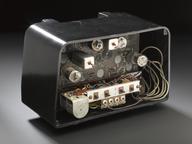

Anti-aircraft No 4 Mark 3 early warning radar set, c.1946
- Made:
- 1946
Anti-aircraft No 4 Mark 3 early warning radar set, less tent [sic] equipment, c.1946. Operated on 212Mc/s wavelength.
Anti-aircraft radar (or AA radar) was was a classification system for British Army radars introduced in 1943 and used into the 1960s when these systems were replaced by missiles with their own integral radar systems.
AA Number 4 was a wide collection of short and medium-range systems known as tactical control radars, whose main purpose was to provide cueing support to the AA Number 3 radars, or "putting on". AA No. 4 Mark 3 was simular to AA No. 4 Marks 1 and 2, but operated on airborne interception radar frequencies and was in use by 1946.
The AA No 4 Mark 3 early warning radar set included a Type 74 Plan Position Indicator (PPI). The PPI technique produced a map-like display and was the standar means of presenting radar information in early radar sets up until the 1980s. In the AA No 4 Mark 3 indicator, the cathode-ray tube screen was scanned radially from the centre by an external coil unit. In order to cover the screen area, the coil unit was mechanically rotated in synchronism with the rotating aerial. Each radar echo was registered as a momentary bright spot on the screen.




